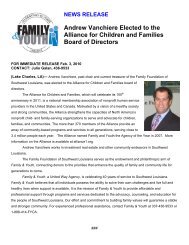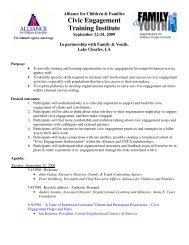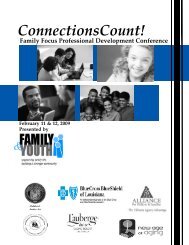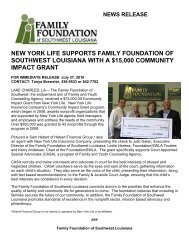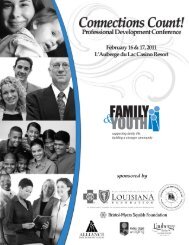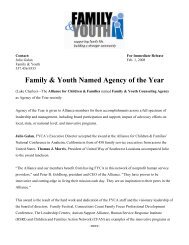Mission-based Advocacy Toolkit from Alliance for Children & Families
Mission-based Advocacy Toolkit from Alliance for Children & Families
Mission-based Advocacy Toolkit from Alliance for Children & Families
Create successful ePaper yourself
Turn your PDF publications into a flip-book with our unique Google optimized e-Paper software.
Alert on Health Savings Accounts and their Impact on EAP Providers<br />
Rising healthcare costs create many concerns <strong>for</strong> families and individuals that struggle to find<br />
ways to pay <strong>for</strong> health services. For some the answer has come in the <strong>for</strong>m of Health Savings<br />
Accounts (HSAs), which arose <strong>from</strong> Medicare legislation passed in 2003. These personal<br />
accounts allow individuals and/or their employers to deposit money <strong>for</strong> future medical expenses,<br />
and these funds are not subject to taxation. Funds in the account carry over annually, and they<br />
remain under the control of the individual regardless of whether or not a person changes jobs. In<br />
order <strong>for</strong> an individual to be eligible <strong>for</strong> these accounts, he or she must be covered by a High<br />
Deductible Health Plan (HDHP). These plans have a minimum deductible of $1,000 <strong>for</strong><br />
individuals or $2,000 <strong>for</strong> a family and annual out-of-pocket costs cannot exceed $5,000 <strong>for</strong><br />
individuals or $10,000 <strong>for</strong> families. High Deductible Health Plans can result in higher out-ofpocket<br />
expenses if care is received outside of the plan’s network, and first dollar coverage (no<br />
deductible) applies only to preventive care. In order to be eligible <strong>for</strong> an HSA, an individual<br />
cannot qualify <strong>for</strong> Medicare or be claimed as a dependent on anyone’s income tax returns.<br />
The current concern with HSAs is that there is a stipulation that the individual must not be<br />
covered by other health insurance plans. The Employee Assistance Professionals Association<br />
(EAPA) states that while this does not apply to injury, accident, disability, dental, vision, or long<br />
term care plans, it is unclear if eligibility <strong>for</strong> an Employee Assistance Program (EAP) would<br />
make a person ineligible <strong>for</strong> a Health Savings Account. If EAPs are classified as not deductible<br />
health plans, then an EAP recipient would not be eligible <strong>for</strong> an HSA. However, if EAPs are not<br />
classified as such, then analysts believe there is no problem with an individual obtaining a Health<br />
Savings Account. Language on HSAs is in the Internal Revenue Service Code of 1986, part VII<br />
of subchapter B of chapter 1, section 223, and there is a provision within that allows <strong>for</strong> a “safe<br />
harbor” if the preventive care deductible has not been met. Thus, while HDHPs can provide<br />
preventive care benefits with a deductible below the minimum annual level (or no deductible at<br />
all), section 223 does not require this type of scenario. Because of this ambiguity, the Internal<br />
Revenue Service at the Department of the Treasury is seeking comments concerning what the<br />
appropriate standard <strong>for</strong> preventive care should be, and to what extent (if any) benefits provided<br />
by Employee Assistance Programs should be included in this standard of preventive care.<br />
Obviously, the financial incentives of HSAs will make them an attractive and popular option <strong>for</strong><br />
those who qualify. Because of this, the future of Employee Assistance Programs and those who<br />
administer them would be uncertain if the EAPs are not classified in a way that allows<br />
employees to take advantage of both plans. The Employee Assistance Professionals Association<br />
has prepared in<strong>for</strong>mation on the effects of the proposed actions by Treasury which can be found<br />
at http://www.eapassn.org/public/pages/index.cfm?pageid=677.<br />
It is <strong>for</strong> this reason that action must be taken by May 28, 2004 to ensure that the U.S.<br />
Department of the Treasury protects the EAPs. If you wish to submit your concerns to<br />
policymakers, please send comments to:<br />
CC:PA:LPD:PR (Notice 2004-2)<br />
Room 5203, Internal Revenue Service<br />
POB 7604<br />
Ben Franklin Station<br />
Washington, DC 20044<br />
Because of the time constraints we would prefer that you e-mail your comments to the following<br />
address: Notice.2004.2.Comments@irscounsel.treas.gov<br />
Please also send us a copy of your comments at policy@alliance1.org<br />
© January 2006 The <strong>Alliance</strong> <strong>for</strong> <strong>Children</strong> and <strong>Families</strong> 125<br />
Appendix I




